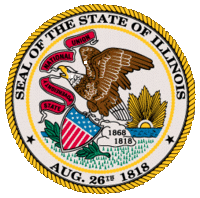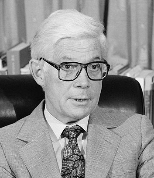Will Santorum Give Illinois Its Most Competitive GOP Primary in 100 Years?
Only one Illinois Republican presidential primary has been decided by less than 10 points out of 25 contests since 1912
 While all recently released polls show Rick Santorum trailing Republican frontrunner Mitt Romney in advance of Tuesday’s primary in Illinois, it is a small miracle that the Prairie State is even remotely competitive at this stage of the campaign.
While all recently released polls show Rick Santorum trailing Republican frontrunner Mitt Romney in advance of Tuesday’s primary in Illinois, it is a small miracle that the Prairie State is even remotely competitive at this stage of the campaign.
Illinois has held its primary in March (1972 through 2004) or February (2008) in each of the last 10 presidential election cycles, but the state has done little to prolong the Republican Party’s nomination battles during this span.
A Smart Politics review of the 25 Illinois GOP presidential primary elections conducted since 1912 finds that only one contest has been decided by less than 10 points, with the winner enjoying an average victory margin of 60 points.
To say that there has been little drama in Illinois Republican primaries in recent decades is an understatement to be sure.
Overall, the winner of the state’s 25 primaries has averaged 77.0 percent of the vote with an average victory margin of 59.8 points.
Even after excluding the reelection campaigns of Ronald Reagan in 1984 and George W. Bush in 2004 – in which these incumbents did not face any primary challengers – the winner of the Illinois GOP primary has still averaged 75.0 points and a margin of victory of 56.3 points.
Illinois has currently backed the eventual GOP nominee in each of the last 14 consecutive election cycles, dating back to 1956 when Dwight Eisenhower ran for his second term.
In that race, Eisenhower defeated California U.S. Senator William Knowland by a 90.8-point margin, 94.9 percent to 4.1 percent.
Perhaps the only impactful contest during this period was Gerald Ford defeating native son Ronald Reagan in the 1976 primary – albeit by a rather uncompetitive 18.8-point margin, 58.9 to 40.1 percent.

Anderson was a 10-term congressman from the state’s 16th district when he sought the GOP nomination in 1980.
He lost to Ronald Reagan by 11.7 points in Illinois, 48.5 percent to 36.8 percent.
Anderson later launched an independent campaign for the presidency, winning 6.6 percent of the vote nationwide.
Prior to 1956, it was quite rare for the Illinois primary winner to go on to secure his party’s nomination – an event that occurred only one time in the first 11 cycles of the state’s primary from 1912 to 1952: Calvin Coolidge in 1924.
Coolidge defeated California U.S. Senator Hiram Johnson by a 58 to 42 percent margin en route to nomination and general election victories later in the year.
Of course, in the era of brokered conventions (and most states not binding delegates to a primary), eventual nominees were frequently not even on a state’s primary ballot during this period.
Moreover, it was common for ‘favorite son’ candidates to win their home state primaries. In Illinois, favorite sons were victorious in:
· 1916: With Illinois U.S. Senator Lawrence Sherman (90.1 percent) defeating Teddy Roosevelt (8.9 percent).
· 1920: With Illinois Governor Frank Lowden (50.5 percent) beating former Army Chief of Staff Leonard Wood (34.0 percent).
· 1928: With Illinois Governor Frank Lowden (99.4 percent) defeating Herbert Hoover (0.4 percent).
· 1936: With Chicago Daily News owner and publisher Frank Knox (53.7 percent) edging Idaho U.S. Senator William Borah (45.8 percent).
· 1948: With businessman Riley Bender (96.9 percent) beating General Douglas MacArthur (2.0 percent) in essentially an uncontested primary.
The 7.9-point victory by Knox in 1936 remains the most narrowly-decided out of the state’s 25 Republican primary contests held thus far since 1912.
A strong performance on Tuesday by Santorum may threaten that mark, and, with four candidates potentially reaching double-digits, a victorious Mitt Romney would almost assuredly fail to win a majority of the vote.
To date, only two winners of the GOP primary have failed to win 50 percent of the vote: Ronald Reagan in 1980 (48.5 percent) and John McCain in 2008 (47.5 percent).
In only four previous Illinois Republican primaries have three candidates reached the double-digit mark:
· In 1920, with Governor Frank Lowden at 50.5 percent, Leonard Wood at 34.0 percent, and Hiram Johnson at 14.4 percent.
· In 1952, with Robert Taft at 73.6 percent, former Minnesota Governor Harold Stassen at 12.2 percent, and Eisenhower at 11.6 percent.
· In 1980, with Reagan at 48.5 percent, John Anderson at 36.8 percent, and George H.W. Bush at 11.0 percent.
· In 2008, with McCain at 47.5 percent, Romney at 28.6 percent, and Mike Huckabee at 16.5 percent.
Four candidates have never reached double digits in the same primary to date.
Illinois Republican Primary Winner and Margin of Victory, 1912-2008
|
Year
|
Date
|
Winner
|
%
|
2nd Place
|
%
|
MoV
|
|
2008
|
February 5
|
John McCain
|
47.5
|
Mitt Romney
|
28.6
|
18.9
|
|
2004
|
March 16
|
George W. Bush
|
100.0
|
(unopposed)
|
0.0
|
100.0
|
|
2000
|
March 21
|
George W. Bush
|
67.4
|
John McCain
|
21.5
|
45.9
|
|
1996
|
March 19
|
Bob Dole
|
65.1
|
Pat Buchanan
|
22.8
|
42.3
|
|
1992
|
March 17
|
George H.W. Bush
|
76.4
|
Pat Buchanan
|
22.5
|
53.9
|
|
1988
|
March 15
|
George H.W. Bush
|
54.7
|
Bob Dole
|
36.0
|
18.7
|
|
1984
|
March 20
|
Ronald Reagan
|
99.9
|
(Scattering)
|
0.1
|
99.9
|
|
1980
|
March 18
|
Ronald Reagan
|
48.5
|
John Anderson
|
36.8
|
11.7
|
|
1976
|
March 16
|
Gerald Ford
|
58.9
|
Ronald Reagan
|
40.1
|
18.8
|
|
1972
|
March 21
|
Richard Nixon
|
97.0
|
George Wallace
|
1.5
|
95.5
|
|
1968
|
June 11
|
Richard Nixon
|
78.1
|
Nelson Rockefeller
|
9.7
|
68.4
|
|
1964
|
April 14
|
Barry Goldwater
|
62.0
|
Margaret Chase Smith
|
25.3
|
36.7
|
|
1960
|
April 12
|
Richard Nixon
|
99.9
|
(Scattering)
|
0.1
|
99.9
|
|
1956
|
April 10
|
Dwight Eisenhower
|
94.9
|
William Knowland
|
4.1
|
90.8
|
|
1952
|
April 8
|
Robert Taft
|
73.6
|
Harold Stassen
|
12.2
|
61.4
|
|
1948
|
April 13
|
Riley Bender
|
96.9
|
Douglas MacArthur
|
2.0
|
94.9
|
|
1944
|
April 11
|
Douglas MacArthur
|
92.0
|
Riley Bender
|
6.3
|
85.7
|
|
1940
|
April 9
|
Thomas Dewey
|
99.9
|
(Scattering)
|
0.1
|
99.9
|
|
1936
|
April 14
|
Frank Knox
|
53.7
|
William Borah
|
45.8
|
7.9
|
|
1932
|
April 13
|
Joseph France
|
99.4
|
Herbert Hoover
|
0.5
|
98.9
|
|
1928
|
April 10
|
Frank Lowden
|
99.4
|
Herbert Hoover
|
0.4
|
99.0
|
|
1924
|
April 8
|
Calvin Coolidge
|
58.0
|
Hiram Johnson
|
42.0
|
16.0
|
|
1920
|
April 13
|
Frank Lowden
|
50.5
|
Leonard Wood
|
34.0
|
16.5
|
|
1916
|
April 11
|
Lawrence Sherman
|
90.1
|
Teddy Roosevelt
|
8.9
|
81.2
|
|
1912
|
April 9
|
Teddy Roosevelt
|
61.1
|
William H. Taft
|
29.2
|
31.9
|
|
—
|
—
|
Average
|
77.0
|
—
|
17.2
|
59.8
|
Table compiled by Smart Politics from data culled from the Illinois Secretary of State and Illinois State Board of Elections.
Follow Smart Politics on Twitter.
